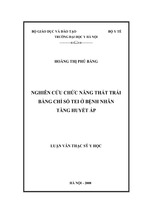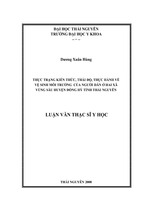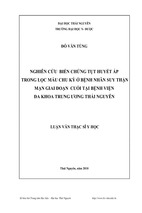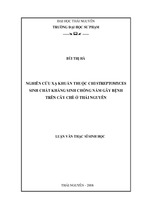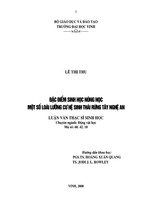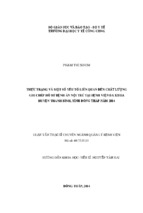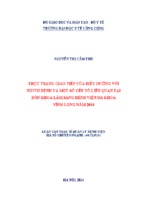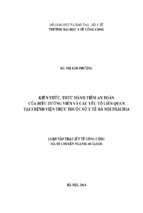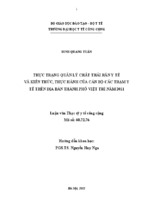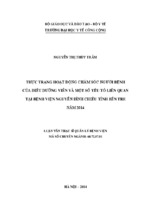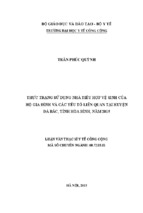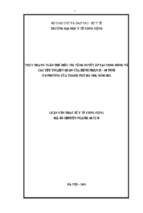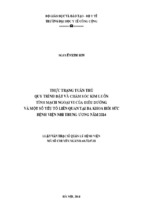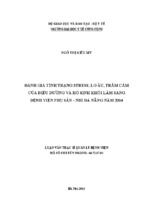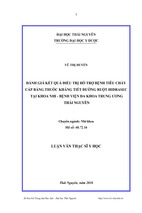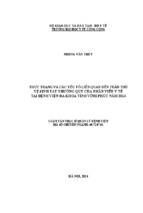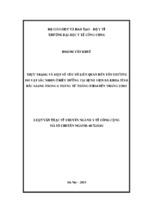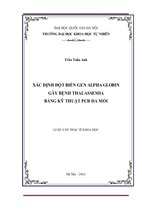Analysis of Coffee-Herbal Beverages
For Potential Benefits Against
Dementia Diseases
A thesis submitted in fulfilment of the requirements for the degree of
Master of Science by Research
Tao Yu
Bachelor of Pharmaceutical Science
School of Science,
College of Science Engineering and Health
RMIT University
May 2017
To my wife Mao YE
For her on-going support and sacrifices,
I dedicate my research to you
2|Page
DECLARATION
I certify that except where due acknowledgement has been made, the work is that of the candidate
alone; the work has not been submitted previously, in whole or in part, to qualify for any other
academic award; the content of the thesis is the result of work which has been carried out since the
official commencement date of the approved research program; any editorial work, paid or unpaid,
carried out by a third party is acknowledged and ethics procedures and guidelines have been
followed.
Tao Yu
1st May 2017
3|Page
ACKNOWLEDGEMENTS
This thesis represents not only my laboratory work, but also the contributions and efforts of those
who guided and helped me. I would like to take this opportunity to express my gratitude for all their
generous input to make this project a success.
First and foremost, I would like to thank my major supervisor Associate Professor Helmut Hugel, for
his expertise, understanding and patience, especially his vast knowledge on herbal protecting
dementia and for his guidance and assistance in writing report (i.e., milestones review, human study
application and this thesis). I have so enjoyed our conversations; and the door of his office was
always open whenever I had a problem or a question about my project or writing.
Secondly Dr Jeff Hughes my surrogate supervisor without whom I would not have achieved my goals.
I am forever grateful for your support, encouragement, and for providing the many opportunities to
attend various workshops to improve my knowledge and skills.
I am appreciative to Mr Paul Morison, for his technical assistance in supporting our SPME-GC/MS
and HPLC-DAD analysis, and Mr Frank Antolasic for making available your equipment and your
assistance in many ways. I am grateful for your friendship, your ongoing words of encouragement
and support during my whole candidature.
I gratefully acknowledge Professor Ewan Blanch and Dr Saeideh Ostovar for Thioflavin T (ThT)
fluorescence assay assessment. I would like to gratefully acknowledge Dr Neale Jackson, who was a
technical consultant on the human sensory evaluation for coffee herbal functional beverage.
To Ms Ruth Cepriano-Hall and Ms Zahra Homan: not only would I like to acknowledge your technical
skills that made it possible for me to perform laboratory work during my studies. I am appreciative
to Dr Oliver Jones, for your assistance that brought me to the chromatography workshop. To the
chromatography workshop supervisor, Dr Ste e
Pi é, I
g ateful fo ha ing an analytical
technical workshop and thanks to your charming personality that daily brightened me up.
4|Page
I would like to acknowledge those people within School of Science at RMIT who assisted me with my
project in one way or another (in alphabetical order): Ms Dianne Mileo, Dr James Tardio, Dr Joel Van
Embden, Mr Karl Lang, Associate professor Kay Latham, Ms Nadio Zakhartchouk, Associate professor
Nichola Porter, and Mr Trevor Rook.
To Dr Lisa Dias and Dr Emma Goethals, I am grateful for your assistance at the every stage during my
studies, which allowed me to complete the milestones successfully.
To my Office (3.2.10)
o s a d these f ie ds f o
Chi a, I ha e so e jo ed ou
offee ti e a d
laughs.
I am eternally blessed to have a loving family who has supported me every step of the way during
stud
hi h I
su e at ti es as a halle gi g task; pa ti ula l the last 100 meters where the
sprint to the finish line has been exhausting. They have brightened up my life with their smiles.
ABSTRACT
The research strategy is focused on the potential prevention and treatment of cognitive
impairment by recommending the consumption of herbal-coffee beverages as early as possible
in life. General methods applicable for the analysis and extraction that are suitable for the
preparation of a range of herbal-coffee beverages have been found. The herb-bioactive
compounds are effectively extracted simply by using a coffee machine or microwave heating.
These herbal-coffee beverages may provide significant neuro-protection against dementia and
Alzhei e s disease, i ludi g the de elop e t of the fi st e a ples o tai i g gi ge , liquorice
and ginseng in coffee brews. Caffeine, caffeic acid and Vitamin B1 combined with HEWL to
strongly inhibit ThT fluorescence. A small study of the perception and sensory responses to the
new beverages was undertaken.
5|Page
JOURNAL PUBLICATIONS ARISING FROM THIS THESIS
Hügel HM, Yu T and Jackson N, The Effects of Coffee Consumption on Cognition and Dementia
Diseases, Gerontology & Geriatric Research 2015(4): 1-6
PRESENTATIONS
1. Tao Yu, Frank Antolasic, Jeff Hughes, Helmut Hugel. TGA-IR-GC-MS Enabling the Analysis of
the Aroma of Roasted Coffee Beans. presented at the Annual Research Day School of
Applied Sciences RMIT, Melbourne, June 2014. (poster)
2. Tao Yu, Paul Mo iso , F a k A tolasi , Jeff Hughes, Hel ut Hugel. The a al sis of he aloffee ta get o pou ds p ote ti e agai st Alzhei e s disease p ese ted at the Annual
Research Day School of Applied Sciences RMIT, Melbourne, June 2015. (poster and oral)
3. Tao Yu, Paul Morison, Frank Antolasic, Neale Jackson, Jeff Hughes, Helmut Hugel. The
analysis of the constituents of herbal-coffees for protection against dementia disease ,
presented at the completion seminar at RMIT University, June 2016. (Oral)
6|Page
TABLE OF CONTENTS
Chapter 1: Introduction……………………………………………………………………………………………………………….16
1.1
Project background………………………………………………………………………………………………………………
1.2
Natural compound extraction methods and quality control……..……………..………………………….
1.2.1 Decoction extraction………………………………………………………………………………………………
1.2.2 Percolation extraction…………………………………………………………………………………………….
1.2.3 Soxhlet Extraction…………………………………………………………………………………………………..
1.2.4 Microwave-assisted extraction……………………………………………………………………………….
1.2.5 SPME extraction……………………………………………………………………………………………………..
1.3
Natural compound quality control [QC] via chromatographic analysis…………………………………
1.3.1 High Performance Liquid Chromatography (HPLC)………………………………………………….
1.3.2 Gas chromatography (GC)………………………………………………………………………………………
1.3.3 Mass spectrometry (MS)…………………………………………………………………………………………
1.4
Thioflavin T (ThT) fluorescence assay…………………………………………………………………………………..
1.4.1 Fluorescence spectrometry measurement…………………………………………………………….
1.5
Coffee herbal Functional beverage………………………………………………………………………………………
1.5.1 Coffee aroma induces/invites functional beverage usage……………………………………….
1.5.2 Herbs are widely used ingredients/nutrients to improve health in food science......35
1.5.3 Functional beverage sensory measuring…………………………………………………………………
1.6
Project Hypothesis and Scope…………………………………………………………………………………………….
1.6.1 Herbal against dementia selection criteria as functional beverage i this p oje t.….
1.6.2 Key questions of the project……………………………………………………………………………………
1.7
Reference……………………………………………………………………………………………………………………………..
Chapter 2:
Coffee Herbal Bioactive Compound’s Potential to Prevent Dementia ….……………….45
.
Multiple ta gets agai st Alzhei e s disease by nature compounds……………………………………
. .
Ta get : A loid β peptide is p odu ed p oteases……………………………………………
2.1.2 Target2: Neurodegeneration accelerated by inflammation and oxidant stress……….
2.1.3 Ta get : Choli este ase i hi itio agai st Alzhei e s disease………………………………
. .
Ta get : Ade osi e e epto s agai st Alzhei e s disease…………………………………….
2.2
Coffee protects against Dementia………………………………………………………………………………………..
2.2.1
Caffeine and coffee Compounds exert protective agai st AD……..…………………………
7|Page
2.3
2.4
2.2.2
Coffee protection against dementia on hu a Studies…………………………………………
Liquorice protects against dementia…………………………………………………………………………………….
2.3.1
Compounds in liquorice that a affe t Alzhei e s disease……………………………….
2.3.2
Liquorice protection against dementia o hu a studies……………………………………..
Ginseng protection against dementia…………………………………………………………………………………
2.4.1
Compounds in ginseng that a affe t Alzhei e s disease…………………………………..
2.4.2
Ginseng protection against dementia i hu a studies………………………………………..
2.5
Ginger protects against dementia………………………………………………………………………………….. …..
2.5.1
Compounds in ginger that a affe t Alzhei e s disease……………………………………..
2.6
References……………………………………………………………………………………………………………………………
Chapter 3:
The analysis of coffee herbal beverages…………………………………………………………………61
3.1
Chromatography method validation parameters………………………………………………………….. …..
3.1.1
Quantification can be achieved by external standards…………………………………………
3.1.2
Peak ide tifi atio ….…………………………………………………………………………………………..
3.1.3
A ua
e o e ……………………………………………………………………………….……………
3.1.4
Precision………………………………………………………………………………………………………………
3.1.5
Linearity……………………………………………………………………………………………………………….
3.1.6
Limits of detection……………………………………………………………………………………………….
. .
Ko áts i de ete tio i de ……………………………………………………………………………..
3.2
The introduction to the coffee and herbal compounds analysis method ….……………………….
3.3
Coffee herbal compounds extraction procedure…………………………………………………………… …..
3.3.1
Coffee, herbal and analysis Instruments and reagents Information………………………
3.3.2
Mode 1: Comparison beverage with an increasing ratio via HPLC and GC/MS………
3.3.3
Mode 2: Comparison of different extraction methods for coffee herbal via HPLC…
3.4
The analysis methods of coffee-herbal beverage……………………………………………………………….
3.4.1 HPLC protocol for coffee and Liquorice………………………………………………………………….
3.4.2 HPLC protocol for ginseng compounds………………………………………………………………….
3.4.3 GC/MS analysis of coffee-herbal beverage…………………………………………………………….
3.4.4 Analytical standards information…………………………………………………………………………..
3.5
Thioflavin T (ThT) spectroscopic assay materials and methods…………………………………………..
3.6
Coffee-herbal beverage analysis results…………………………………………………………………………….
3.6.1 Validation of the HPLC assay………………………………………………………………………………….
3.6.2 Validation of the GC/MS assay………………………………………………………………………………
8|Page
3.6.3
3.6.4
3.6.5
3.6.2.1 Method validation by Kováts index (KI)…………………………………………………..
. . .
Ca phe e ali atio u es…………………………………………………………………
Mode 1: Compounds concentration in coffee-herbal beverage……………………………..
Herbal compounds of camphene concentration in coffee-herbal beverage…………..
Mode2: Coffee herbal beverage with various extraction methods…………………………
3.7
Thioflavin T (ThT) assay measurement……………………………………………………………………………….
.
Refe e e…………………………………………………………………………………………………………………………
Chapter 4:
Coffee herbal beverage sensory estimation……………………………………………. …….90
4.1
Functional beverage sensory measurement………………………………………………………………………
4.2
Coffee herbal beverage constituents on sensory ……………..………………………………………………
4.3
Sensory assessment (9-point hedonic scale) applications in food science…………………………
4.4
Participant recruitment
4.5
Coffee-herbal beverage preparation ………………………………………………………………………………
4.6
Coffee herbal beverage sensory assessment procedure………………………………………………… …
4.7
Sensory measurement protocol………………………………………………………………………………………..
4.8
Hedonic scale statistical analysis……………………………………………………………………………………….
4.9
Hedonic scale record discussion………………………………………………………………………………………..
.
Refe e es………………………………………………………………………………………………………………………..
Chapter 5:
ethod ………………………………………………………………………………………
Conclusions and further work…………………………………………….…………………………………98
5.1
Co lusio ………………………………………………………………………………………………………………………….
5.2
suggestion for further work……………………………………………………………………………………………..
Appendix 1 Herbal Coffee Beverage Sensory Analysis Evaluation………………………………………………….
9|Page
LIST OF FIGURES
Chapter 1
1.1
1.2
1.3
1.4
1.5
1.6
1.7
1.8
1.9
a The Alzhei e s Disease de elop e t stage; Neu oi agi g f o a health pe so
a d a patie t ith Alzhei e s disease……………………………………………………………………………….
(a)Percolation extraction; (b)Conventional Soxhlet Extraction;(c)Microwave-assisted
extraction…………………………………………………………………………………………………………………………….
(a)Manual Solid-phase microextraction (SPME) Holder; (b) SPME extraction process
of absorption and release……………………………………………………………………………………………….……
(a)The components separation process; (b)Individual retention time of the compound A
a d B elutio f o the olu …………………………………………………………………………………………….
(a) Schematic of HPLC separation procedure and data obtained displays; (b) HPLC instrument;
(c) HPLC-DAD(diode-array detection ) compo e ts.……………………………………………………………
Schematic of a typical simple GC-MS……………………………………………………………………………….....
Configuration of quadrupole mass filter…………………………………………………………………………..….
(a) The structure of Thioflavin T(ThT); (b)Magnified view of the ThT– i di g β a loid sheet
deposits. (c) Essential component of a fluorescence spectrometer (d)Characteristic increase
in ThT fluorescence upo i di g to a loid fi ils…………………………………………………………….
Typical sample preparation and separation steps involved in GC/MS and HPLC…………………..
Chapter 2
2.1
2.2
.
.
2.5
2.6
Amyloid cascade hypothesis……………………………………………………………………………………………….
Enzymatic processing of transmembrane APP: the non-amyloidogenic(a) and
a loidoge i path a s ……………………………………………………………………………………………….
Caffei e, t igo elli e a d affei a id………………………………………………………………………………….
β-Glycyrrhizic acid converts to a stable inclusion complex with other
molecules (GA do ut i g …………………………………………………………………………………………………
Glycyrrhizic acid (GA) and Glabridin…………………………………………………………………………………….
a Gi se osides R , Rg ;
α-Pi e e, β-Pinene and Camphene ……………………………………
Chapter 3
3.1
3.2
3.3
3.4
3.5
3.6
3.7
3.8
HPLC chromatogram of standard solution of Tigonelline, Caffeine and Glycyrrhizic acid (GA)73
HPLC chromatogram of standard solution of Ginsenoside Rb1………………………………………… ….
Calibration curves of Tigonelline, Caffeine and Glycyrrhizic acid (GA) and Ginsenoside
Rb1 the regression equations of the four compounds………………………………………………………. ..74
GC chromatogram of standard of n-alkanes (C8-C20)……………………………………………………………
GC chromatogram of coffee-ginger beverage……………………………………………………………………….
Calibration curves of Camphene the regression equations in the both range……………………….
GC/MS chromatogram of standards solution of Camphene and Caffeine……………………………..
Coffee herbal beverage sample HPLC chromatogram of Trigonelline, caffeine and GA
10 | P a g e
3.9
3.10
3.11
3.12
3.13
and dilution (1:10) with 25% methanol…………………………………………………………………………………
Coffee herbal beverage sample HPLC chromatogram of Rb1(AG) and dilution (1:10)
with 25% Acetonitrile……………………………………………………………………………………………………………
Coffee herbal beverage sample GC/MS chromatogram of camphene and caffeine………………
The coffee herbal beverage compounds concentration measurements via various
extraction methods………………………………………………………………………………………………………………
The amount of compounds extraction via microwave oven extraction…………………………………
Semi-quantitative curve of protein fibrillation in the presence or absence of different
Natu e o pou ds……………………………………………………………………………………………………………….
Chapter 4
4.1
4.2
4.3
Texture of Hedonic Scales values in coffee herbal beverage………………………………………………
Flavors of Hedonic Scales values in coffee herbal beverage………………………………………………. .
Tasty of Hedonic Scales values in coffee herbal beverage…………………………………………………….
11 | P a g e
LIST OF TABLES
Chapter 1
1.1
A brief summary of the experimental conditions for various methods of extraction for
herbal material……………………………………………………………………………………………………………………
Chapter 3
3.1
3.2
3.3
3.4
3.5
3.6
3.7
3.8
3.9
3.10
3.11
3.12
3.13
Coffee and herbs products information list………………………………………………………………………….
Coffee a d he al i tu e i g edie ts a d atio list…………………………………………………………….
Standards information list……………………………………………………………………………………………………
Regression equations and detection limits of components determined for the presented
HPLC assay…………………………………………………………………………………………………………………………..
Intra-day precision and accuracy for the HPLC assay of four components……………………………
Comparison of three times n-alkanes (C8-C20) Kovats Indices and the percent of quality
ass at h…………………………………………………………………………………………………………………………
Comparison of three times monoterpenoid and caffeine Kovats Indices and the percent
of quality mass match………………………………………………………………………………………………………….
Regression equations and detection limits of components determined for the
presented GC/MS assay……………………………………………………………………………………………………….
Intra-day precision for the GC/MS assay of ginger component (n=4)……………………………………
Amounts peak area and the concentration of caffeine, trigonelline in coffee-herbal
beverage (n=4)…………………………………………………………………………………………………………………….
Comparison of peak area and the concentration of GA from liquorice powder (LP), GA
from liquorice liquid extract(LL) in coffee-herbal beverages (n=3)……………………………………….
Comparison of peak area and the concentration of Rb1 from American ginseng (AG),
Rb1 from unidentified ginseng source (UG) in coffee-herbal beverage (n=3)……………………….
Comparison of peak area and the concentration of camphene from fresh ginger (FG),
and from Ginger capsule(GC) in coffee-herbal beverages
…………………………………………..
12 | P a g e
LIST OF ABBREVIATIONS
Aβ
A
ACh
Acetylcholine
AChE
Acetylcholine cholinesterase,
AD
Alzhei e s disease
APP
Amyloid precursor protein
BuChE
Butyryl-cholinesterase
CI
Chemical Ionisation
DAD
Diode Array Detector
DHA
Docosahexaenoic acid
GA
Glycyrrhizic acid
GC
Gas Chromatography
Rb1
Ginsenoside Rb1
Rg1
Ginsenoside Rg1
EI
Electron ionization
FID
Flame ionization deection
HPLC
High Performance Liquid Chromatography
KI
Kováts index
m/z
mass to charge ratio
MAE
Microwave-assisted extraction.
MCI
Mild cognitive impairment
MQ water
Milli-Q water
MS
Mass spectrometry
NMDA Receptor
N-methyl D-aspartate Receptor
NPD
Nitrogen–phosphorus
PBS
Phosphate buffer saline
PDMS
Polydimethylsiloxane
PMAE
Pressurized microwave-assisted extraction
QC
Quality control
SFMAE
Solvent-free microwave-assisted extraction
SPME
Solid phase microextraction
RPC
Reversed-phase chromatography
RSD%
The percent of Relative standard deviation
SD
Standard deviation
loid β peptides
13 | P a g e
S/N
Signal to Nosie ratio
SIM
selected ion monitoring
TIC
total ion chromatogram
ThT
Thioflavin T
14 | P a g e
1
Introduction
The ore i porta t reaso is that the resear h itself provides a i porta t lo g-run perspective on the
issues that we face on a day-to-day asis.
Ben Bernanke
1.1 Project Background
By 2050 it is estimated that the number of people over the age of 80 will triple globally and cognitive
decline and dementia could become the greatest challenge of our times. According to the 2003
World Health Estimates Report, dementia inflicts 11.2% elderly people (>60 years) more than stroke,
cardiovascular disease and various cancers [1]. Dementia is a collection of different disorders that
influence brain function such as progressive memory loss, judgment decline and other symptoms;
Alzhei e s disease (AD) is the most common type of memory disorder and contributes to between
50% and 70% of all types of dementia [2]. From neuroimaging, AD advances in three stages: an early
and preclinical stage with no symptoms; a middle stage of mild cognitive impairment (MCI); and a
final stage of AD. [3] [Fig.1.1 (a)] The pathological process of AD can have a long development time
even to 40-50 years (including the early and MCI periods) [4].
MCI is defined as the clinical condition of memory between normal aging and AD; in other words,
patients with MCI incur more memory loss problems than healthy people of a similar age, however
they do not yet have the cognitive function issues and criteria for AD [5]. According to
epidemiological studies, elderly people have been classified as the highest risk of population to
suffer from AD [6]. For example, the many memory complaints elderly people have include, having
trouble remembering friends names they meet often, having a greater probability to misplace things
15 | P a g e
yet have normal judgment and thinking skills. These people can suffer from MCI for extended
periods of time. They are at high risk (approximately 80%) of accelerating to a dementia disorder
such as AD (mostly in 6 years); however their dementia may be slowed even stabilised after
satisfactory therapeutic and lifestyle interventions [7].
Therefore, aging associated memory
impairment is a major risk factor for the general degradation of memory that can progress from MCI
[8,9] symptoms to AD [10]. Although it is difficult to dete
i e
hethe a pe so s
e o
loss
reflects MCI symptoms. Aging is the highest risk factor that necessitates medical treatment for AD
for which there is no known cure.
Fig.1.1 (a) The AD development stages (left). (b) Neuroimaging from a healthy person (the left of
picture b) a d a patie t ith Alzhei e s disease ight [Rep odu ed f o
efe e es 3, 14]
MCI symptoms and dementia is most likely caused by amyloid fibrils neurodegeneration that affect
brain cells to communicate neural information, resulting in memory loss and behaviour and feeling
changes. Damage in the memory and judgement functional regions such as the temporal lobe and
corpus callosum [Fig.1.1 (b)] is the cause of memory loss and one of the earliest symptoms of AD.
Amyloid fibrils are aggregated by normally soluble amyloid protein and are found in a wide range of
misfolded β-sheet amyloid protein resistant to neuro-degradation [11]. Research studies indicate the
structure of fibrils are mainly composed of β-sheet structure in a characteristic cross-β o fo
[12]. Therefore, a
loid β peptides Aβ a e the
ai
o po e ts of the a
atio
loid pla ues fou d i
the brains of Alzheimer patients where it is deposited abnormally in senile plaques containing both
16 | P a g e
Aβ
a d Aβ
. Aβ is produced from the amyloid precursor protein (APP) by the sequential cleavage
ia β- and γ-secretases [13]. Currently there are no medications that can remove or affect the
dissolution of toxic Aβ f o
eu o s to i p o e og iti e a ilit .
Symptomatic treatments have been widely applied for AD since the mid-1990s. There are two types
of medications, cholinesterase inhibitors (Donepezil, Rivastigmine, Galantamine) and NMDA
receptor antagonist (Memantine), that are approved by the USA Food and Drug Administration to
relieve the cognitive symptoms (such as memory loss, confusion) of mild, moderate and severe AD
[14] These drugs are based on sustaining the acetylcholine (ACh) neurotransmitter levels
(galantamine and the physostigmine-derivative rivastigmine) [15] in AD patients with cognitive
degeneration have cholinergic neurons deficits in due to a decline in the levels of ACh in the
hippocampus, temporal and parietal neocortex.
ACh is hydrolytically destroyed by two
cholinesterases, AChE and butyryl-cholinesterase (BuChE). As AD progresses, AChE activity can
decrease by up to 67% of normal levels in the temporal lobe and hippocampus [16]. Thus,
Cholinesterase inhibitors are commonly used for the treatment of symptoms of AD cognitive decline,
but does not stop/prevent neuronal damage. NMDA glutamate receptors are composed of abundant
glutamate-gated cation channels with high calcium permeability, which are distributed throughout
the central nervous system (CNS). They have important roles in the process that learning, memory,
and neuroplasticity. Some neurological disorders including cognitive disorders are caused by
receptor over activation (excitotoxicity) and subsequent neurodegeneration [17,18]. Many AD
patient s memory loss and cognitive loss is due to prolonged Ca2+ excess and results in loss of
synaptic function, followed by synaptotoxicity and ultimately cell death [19]. It is known that NMDA
receptor inhibition and overactivation, leads to impairment of neuronal plasticity (learning) or cell
death, and dysfunctional cognition [20]. Memantine is a low affinity, voltage-dependent and
noncompetitive NMDA receptor antagonist, which has a higher affinity for Mg2+ and blocks Ca2+
influx. It has fast off-rate kinetics in the receptor channel, and so is only of benefit for dysfunctional
synapses found in AD patients without affecting the physiological stimuli of the NMDA receptor [21].
Many AD patients have been recorded to have personality changes, behaviour and sleep difficulties
even at the early stage. For example, the major behaviour alteration was apathy (72%), agitation
(60%) and anxiety (48%), which significantly correlates to the cognitive deterioration caused by
neuron cell damage in the brain [22]. Additionally, some medications may worsen these symptoms.
Therefore, atypical antipsychotics such as risperidone, quetiapine, olanzapine, aripiprazole were
utilized to treat the symptoms of short-term severe aggression in AD. However, these drugs have
limited cognitive benefits, particularly risperidone that poses a significant risk for cerebrovascular
17 | P a g e
events [23, 24]. Currently, all antidepressants such as citalopram, sertraline are not licenced for AD
treatment.
In summary, many researchers acknowledge that current Alzhei e s drugs cannot cure AD. These
drugs and non-drug clinical conditions may ameliorate cognitive and behavioural symptoms for
improving the quality of life for some patients with AD.
A better strategy is to prevent AD onset or delay aging through the reduction of dementia risk
factors; as the medications used to treat mild cognitive or dementia do not reverse the formation of
eu ofi illa
ta gles . There are seven risk factors that have been associated with one in three
Alzheimer's disease cases. These include diabetes, midlife hypertension, midlife obesity, physical
inactivity, smoking, depression, or low educational attainment [25,26]. These risk factors could
promote AD with aging. The current lifestyle interventions preventing AD include better diets, brain
games (Sudoku puzzles) and regular exercise. For example, research suggests that daily intake of fish
with docosahexaenoic acid (DHA), and omega-3 fatty acid decreases the risk for AD [27]. Neurons
and synapses are composed of long chain unsaturated fatty acids similar to omega-3; also lowering
the dementia risk factors is related to the protection against cardiovascular disease [28].
Scientific research demonstrates that strategies such as exercise and diet, significantly delay or
prevent aging cognitive decline or memory loss, many of which are based on small group and shortterm studies. Obviously the dietary nutrition brain benefits are variable and it is common for people
to take different kinds of foods containing vitamins, antioxidants and their effects are difficult to
quantify. There is room for improvement, especially in generating personalised treatments, however
the greatest advantage of dietary modifications is that they generally do not raise human safety
issues.
The health claims of traditional herbal remedies, their effectiveness and safe use are growing
rapidly. Functional foods are also popular for consumers who are seeking specific health effects to
promote physical fitness. Recent research found that many herbal compounds can affect the mind,
mood, cognitive function or health. For example, ginseng has been reported to improve short-term
memory performance when consumed as a dietary supplement. S. lavandulaefolia Vahl. (Spanish
sage) essential oil composition i ludes α-pinene (4%- % , β-pinene (5%-12%), 1,8-cineole (15%30%) and camphor (20%-30%, and it has been reported to improve accuracy for cognitive mental
status examination after 6 week of use [29]. Certain herbs may be potentially important sources of
18 | P a g e
drug candidates against the onset of AD. For example, Zingiber officinale (ginger), Ginkgo biloba
(ginkgo), Cinnamum cassia (Chinese cinnamon) extracts effectively protect primary neuronal cells
agai st Aβ -42 insult [30]. Huperzine A, originally isolated from Huperzia serrata, a type of moss
used in traditional Indian and Chinese medicine and its derivative, ZT-1, is being developed as a new
anti-AD drug for AD treatment. Yokukansan is composed of 7 herbs and is a useful formulation for
the effective treatment of dementia symptoms in 106 patients diagnosed with AD that was safe to
use [31].
The production of a functional beverage using safety tractional herbs and to encourage its long term
consumption would provide a sound strategy for neuroprotection against dementia and be of
general benefits for society. Firstly, these herbal effective compounds can be extracted into water
via a convenient procedure; moreover, these ingredients can be analytically measured the amount
consumed can be quality controlled, allowing the opportunity to monitor/measure the benefits over
several years; the last but not the least factor is the functional beverage can be modified according
to personal sensory perceptions and blended into daily consumption similar to coffee or tea intake.
1.2
Natural compound extraction methods and quality control
In order to quantify the herbal benefits for human health, the first important step is herb
constituent extraction, separation, identification and quantitation/concentration of the herbal
ingredients, as the bioactive compound concentration are product quality-related and also to herbal
efficiency. These herbal bioactive substances can be classified into families of compounds including
essential oils, alkaloids, steroids, saponins. Various classes of compounds have known methods for
extraction for optimal pharmaceutical application [32]. For example, some bioactives found in plants
are water soluble whilst others are hydrophobic/insoluble. Modern and traditional extraction and
analysis techniques play an important role in food industry [33,34]. These techniques include
decoction, percolation, Soxhlet extraction, solid phase micro-extraction, and microwave-assisted
extraction, that are available in the lab or in domestic use. Chromatographic techniques have proven
to be the most powerful and effective technology available for herbal analysis [35].
1.2.1
Decoction extraction
The usage of green extraction technology (also traditional extraction techniques) is able to protect
the natural environment and minimizes harmful chemical affects on human and environmental
19 | P a g e
health. Traditional Chinese herbal teas and Turkish coffee are commonly prepared in this way. For
decoction methods, the extractive yield is determined by time/temperature and the chemical nature
of the herb. Botanic herbs such as stem and root from licorice, ginseng and ginger, are finely ground
to enhance maximum herb extraction [36]. Water is biocompatible and an eco-friendly medium,
which can be used to extract many bioactive constituents including alkaloids, flavonoids, saponins,
vitamins and others [37]. The herbs to water ratio used ranges from 1:4 to 1:10. Depending on the
consistency of the parts to be extracted, the decoction times of herbs generally decreases in the
order: roots > stems > leaves and flowers, when boiled in water for 5 to 60 minutes [38,39]. During
this time the evaporated water must be replaced. Essential oils are isolated by distillation of the
volatile organic compounds.
1.2.2
Percolation extraction
Percolation is an extraction process whereby the slow passage of a solvent through fine substrate
particles extracts constituents that pass through the filter into the collector. A coffee percolator is a
good example of the percolation process, which was invented by Hanson Goodrich in 1889 [40].
Water is heated in the percolator chamber, passes through the vertical tube as steam-powered
vacuum and is sprayed over the coffee grounds (that is continuously recycled through the grounds
until complete) [Fig. 1.2(a)]. Extracted coffee was filtered into the bottom chamber. Percolation is a
short and efficient extraction extraction procedure that can be applied to the extraction of certain
herbs [41]. As required, the coffee or herbs should be ground into powder form with a coffee
blender or commercial grinder. Some procedures require a preparatory step, to allow crude herbal
particles to swell to their maximum size as dense dry fine particles may block the filter mesh after
swelling and resist solvent flow, giving rise to inefficient extraction [42].
20 | P a g e
- Xem thêm -

